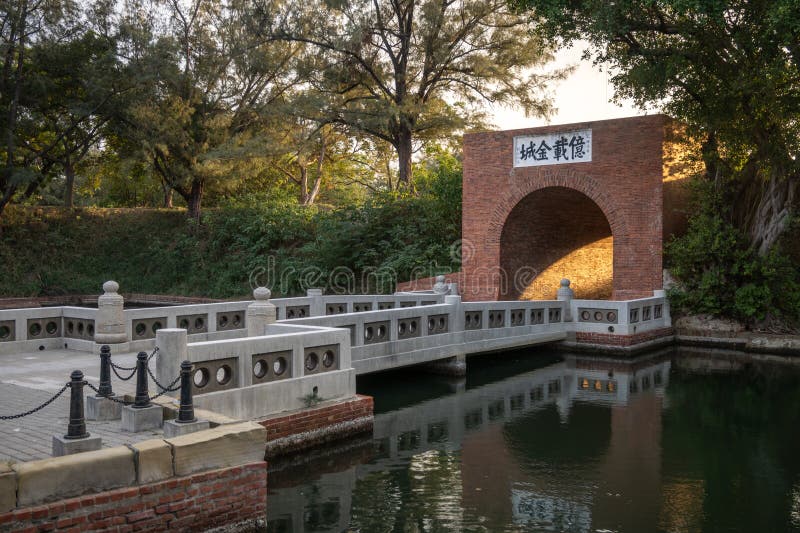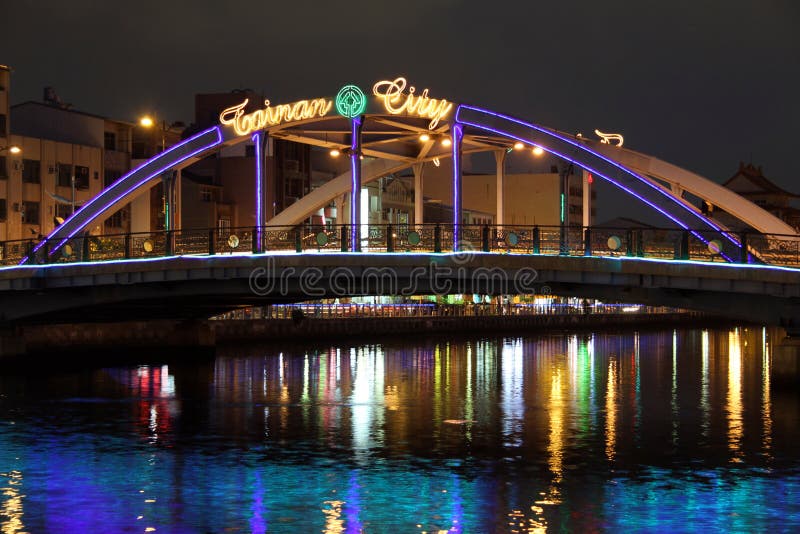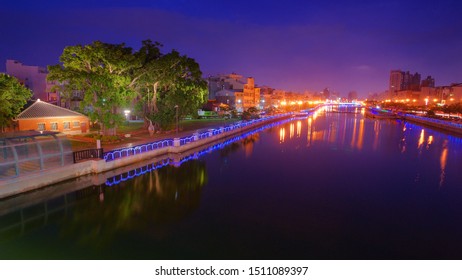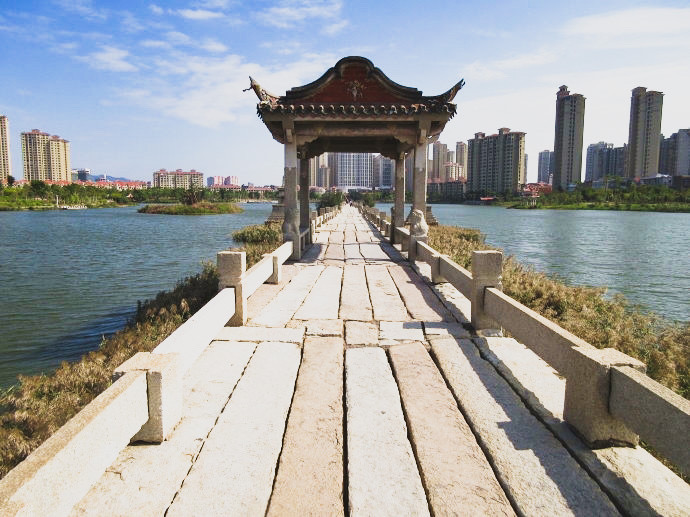The Ultimate Guide to Visiting Anping Bridge in Tainan, Taiwan

An Essential Guide to Visiting Anping Bridge
Nestled in the scenic Anhai Town of Jinjiang, Anping Bridge (安平桥) stands as a testament to China’s rich history and architectural ingenuity. This ancient stone bridge, with its impressive length and striking design, is more than just a crossing; it is a serene escape enveloped by nature, where locals and travelers alike come to stroll, jog, and soak in the tranquility of the surrounding parkland. As you walk along its reconstructed pathways, originally paved with stones that date back centuries, you can almost feel the whispers of history echoing through time.
Whether you’re an avid history buff or simply seeking a peaceful retreat from the hustle and bustle of modern life, the bridge and its picturesque setting promise a delightful experience. The park surrounding Anping Bridge offers ample opportunities for leisurely walks or quiet reflection, making it a perfect stop for those exploring the cultural treasures of Fujian Province. So lace up your walking shoes, grab your camera, and prepare to be enchanted by the beauty and heritage of Anping Bridge—an essential destination on any travel itinerary.
In This Guide
- An Essential Guide to Visiting Anping Bridge
- The Rich History and Legends of Anping Bridge
- Main Highlights: What You Absolutely Can’t Miss
- Planning Your Visit: A Practical Guide
- Tickets: Prices, Booking, and Tips
- How to Get There: A Complete Transportation Guide
- Local Cuisine and Accommodation Nearby
- Frequently Asked Questions
- Final Thoughts on Your Trip
The Rich History and Legends of Anping Bridge
Nestled in the charming town of Jinjiang, the Anping Bridge stands as a testament to centuries of history and the rich tapestry of legends that surround it. Originally constructed during the Song Dynasty over a millennium ago, this ancient stone bridge serves not only as a functional structure but also as a cultural landmark that encapsulates the spirit of a bygone era.
The bridge was built using large, meticulously cut stones, showcasing the advanced architectural techniques of its time. It was initially a vital link across the river, facilitating trade and travel along the historic Silk Road—an essential route for commerce that connected the East and West. As travelers crossed its sturdy archways, they were not merely traversing a bridge; they were stepping into a narrative woven with tales of merchants, diplomats, and explorers who once relied on this path.
Anping Bridge has undergone various reconstructions throughout the centuries, ensuring its preservation and continued relevance in the local community. Each renovation has been carefully executed to maintain the integrity of the original design while enhancing the bridge’s accessibility and beauty. Today, visitors can admire both the historical stones and the picturesque setting that surrounds this iconic landmark, making it a perfect spot for leisurely strolls and reflection.
Legends surrounding the Anping Bridge add an enchanting layer to its historical significance. One popular tale speaks of a local scholar who, after crossing the bridge, achieved enlightenment and went on to become a revered figure in his community. His image is said to watch over the bridge, providing blessings to those who cross it. These stories, passed down through generations, create a sense of connection and reverence among visitors and locals alike.
The bridge is not only a place of historical intrigue but also a vibrant community park where life flourishes. As you walk along the pathways lined with lush greenery, you will encounter friendly locals engaging in leisurely activities, from jogging to enjoying family picnics. The serene lake nearby reflects the bridge’s elegant structure, creating a picturesque setting for photography and contemplation.
In essence, Anping Bridge is more than just a crossing over water; it is a bridge through time, connecting the present to a storied past. For travelers seeking a glimpse into the rich history and legends of this remarkable structure, a visit to Anping Bridge is an experience that promises to leave a lasting impression. Whether you are captivated by its architectural beauty or enchanted by the tales that echo through its arches, this historic bridge invites all to partake in its enduring legacy.

Anping Bridge.
Main Highlights: What You Absolutely Can’t Miss
Anping Bridge, an architectural gem nestled in the scenic Jinjiang region of Fujian, is more than just a bridge; it’s a celebration of history, culture, and natural beauty that international travelers simply cannot overlook. Here’s a guide to the main highlights that will enrich your visit to this remarkable site.
A Walk Through History
The bridge, originally built during the Song Dynasty, is a stunning example of ancient engineering, showcasing large, intricately cut stones that have stood the test of time. As you stroll across its lengthy span, take a moment to appreciate the craftsmanship and the stories woven into its structure. It’s not merely a bridge; it’s a historical testament to the connectivity of trade routes, including the famed Silk Road.
Picturesque Surroundings
Set within a sprawling park, Anping Bridge offers a tranquil escape from the bustling city. The lush greenery and serene lake create a picturesque backdrop for leisurely walks or a quiet afternoon of reflection. Many visitors enjoy walking or jogging around the park, mingling with friendly locals who frequent the area for their daily exercise. The ambiance is perfect for unwinding and soaking in the natural beauty that surrounds you.
Ideal Photo Opportunities
The bridge itself is a striking feature that begs to be photographed. As you capture its grandeur, don’t miss the chance to frame it against the stunning views of the lake and park. Sunrise and sunset offer particularly magical lighting for photos, so plan your visit accordingly if you’re keen on capturing that perfect shot.
Cultural Insights
At both ends of the bridge, you’ll find small temples and statues, such as the one honoring Cai Xiang, a notable scholar from the Song Dynasty. These elements add a cultural depth to your experience, offering insights into the historical significance of the area. Take your time to explore these features and reflect on their meanings as part of the rich tapestry of Chinese heritage.
A Community Hub
Anping Bridge is not just a tourist attraction; it’s a vibrant community hub. During your visit, you’ll likely encounter local families enjoying picnics, children playing, and elders practicing tai chi. Engaging with the locals can enrich your experience, providing a glimpse into daily life in Jinjiang. Don’t hesitate to strike up a conversation; the warmth of the community is one of the bridge’s hidden gems.
Nearby Attractions
If time allows, consider exploring nearby sites such as the Quanzhou Longshan Temple or the Zheng Chenggong Mausoleum, both of which offer additional layers of cultural and historical significance. These attractions are easily accessible and provide a well-rounded experience of the region’s rich heritage.
Conclusion
Anping Bridge is a must-visit destination that beautifully blends history, culture, and nature. Whether you’re an avid history buff, a photography enthusiast, or simply seeking a peaceful place to unwind, this iconic bridge and its surrounding park offer something for everyone. Make sure to add Anping Bridge to your travel itinerary—it’s an experience you won’t want to miss!

Anping Bridge.
Planning Your Visit: A Practical Guide
Visiting Anping Bridge is a delightful experience that offers a unique blend of history and natural beauty. As you plan your visit, here are essential tips and information to enhance your journey to this stunning landmark.
Getting There
Location: Anping Bridge is located in Anhai Town, Jinjiang, Fujian Province, China. The park surrounding the bridge is easily accessible from the city center.
Transportation:
– By Car: Consider hiring a taxi or using a ride-hailing app to get directly to the park. There is ample parking available nearby.
– Public Transport: Buses and local transit options are available, but ensure to check the latest schedules as they can vary.
Best Time to Visit
Anping Bridge is open year-round, but the ideal time to visit is during autumn (September to November) when the weather is mild and comfortable for walking. Early mornings or late afternoons can be particularly pleasant, allowing you to enjoy the peaceful atmosphere and stunning views.
Park Hours
The park surrounding Anping Bridge is open daily from 8:00 AM to 5:30 PM. Plan accordingly to make the most of your visit.
What to Expect
The Bridge: Anping Bridge, while reconstructed, retains many of its original stones and offers a picturesque setting. The long, straight structure is perfect for leisurely strolls and photography.
Scenic Park: The area around the bridge is a community park that spans several miles. You can enjoy walking or jogging along the lakeside paths, watching local residents engage in their daily routines, and soaking in the serene environment.
Cultural Touchpoints: As you explore, you’ll encounter local vendors, small temples, and historical markers that provide insights into the bridge’s significance and its role in the region’s history.
Nearby Attractions
After visiting the bridge, consider exploring these nearby attractions:
– Quanzhou Longshan Temple (1.6 miles away): A beautiful religious site steeped in history.
– Zheng Chenggong Mausoleum: An important historic site dedicated to the renowned military leader.
– Local Restaurants: Sample the regional cuisine at nearby eateries, such as Chocolicious, located just over 2 miles from the bridge.
Tips for Your Visit
- Bring Water and Snacks: While there are some vending options, it’s wise to carry refreshments, especially if you plan to spend several hours exploring.
- Wear Comfortable Shoes: The park is expansive, and you’ll want to walk around to fully appreciate the scenery.
- Plan for Photography: The bridge and park provide stunning backdrops, so don’t forget your camera or smartphone for capturing memories!
Safety and Etiquette
- Respect Local Customs: As you interact with residents and fellow travelers, a friendly demeanor goes a long way. Simple greetings in Mandarin can enhance your experience.
- Stay Hydrated: Particularly during warmer months, drinking water is essential as you walk around the park.
Conclusion
Anping Bridge is more than just a historical landmark; it’s a gateway to experiencing the local culture and enjoying the natural beauty of Jinjiang. With this practical guide in hand, you’re well-equipped to make the most of your visit. Enjoy your adventure!

Anping Bridge.
Tickets: Prices, Booking, and Tips
Visiting Anping Bridge is a delightful experience that offers a glimpse into the rich history and culture of the region. Here’s what you need to know about ticketing, booking, and some handy tips for your visit.
Ticket Information
Entry to Anping Bridge is completely free! This makes it an accessible destination for international travelers looking to explore the bridge and its surrounding park without any cost. While you won’t need to purchase tickets, be sure to bring some cash if you plan to enjoy local snacks or souvenirs from nearby vendors.
Booking Recommendations
Although Anping Bridge does not require advanced reservations, consider booking guided tours or experiences in the Jinjiang area to enhance your visit. Private day tours often include transportation to and from the bridge, along with insights from knowledgeable guides about the area’s history and significance.
Tips for Your Visit
-
Timing Your Visit: The bridge and park are open daily from 8:00 AM to 5:30 PM. For a more peaceful experience, try visiting early in the morning or later in the afternoon, when the light is lovely for photographs.
-
Exploring the Area: Take advantage of the expansive park surrounding the bridge. It’s perfect for a leisurely stroll, jogging, or simply relaxing while soaking in the scenic views. Bring comfortable shoes as you may want to explore various paths around the lake.
-
Local Interaction: Engage with friendly locals who frequent the park. They can provide insights and recommendations, making your visit more enriching.
-
Plan for Amenities: While there are limited dining options directly at the bridge, nearby areas offer various local eateries. It’s a great opportunity to sample regional delicacies after your visit.
-
Transportation: If you’re coming from Xiamen or other nearby cities, consider hiring a car or joining a tour group for convenience. This way, you can enjoy the comfort of a guided trip while discovering other nearby attractions.
Enjoy your visit to Anping Bridge, where history and natural beauty come together in a stunning setting!
How to Get There: A Complete Transportation Guide
To reach the picturesque Anping Bridge (安平桥) in Jinjiang, China, you have several convenient transportation options tailored for international travelers. Nestled in a historic park, the bridge is not only a sight to behold but also a gateway to the area’s rich culture and history. Here’s how you can get there:
By Air
Jinjiang Airport (JJN) is the nearest airport, located approximately 10 km from Anping Bridge. This airport offers domestic flights, as well as a few international connections. Upon arrival, you can opt for the following modes of transportation:
- Taxi: Taxis are readily available outside the terminal. The ride to Anping Bridge should take around 15-20 minutes and cost approximately 30-50 RMB (around $5-$8).
- Airport Shuttle: Some hotels may provide shuttle services. Check with your accommodation if this option is available.
Xiamen Gaoqi International Airport (XMN) is another option, located about 60 km away. From here, you can reach Anping Bridge via:
- Taxi: A taxi ride will take around an hour, costing approximately 150-200 RMB (about $23-$31).
- Bus: Take a long-distance bus from Xiamen to Jinjiang, which is a cost-effective option but may take longer.
By Train
Jinjiang has its own train station, making it easily accessible by rail. High-speed trains from major cities like Xiamen, Quanzhou, and Fuzhou regularly service this route. Upon arriving at Jinjiang Railway Station, you can:
- Take a Taxi: The bridge is about 8 km from the train station, and a taxi ride will take approximately 15 minutes for about 20-30 RMB (around $3-$5).
- Public Bus: Local buses are available, though you may need to check the schedules. This option is more economical but might take longer due to stops.
By Bus
For budget-conscious travelers, intercity buses are a popular choice. You can catch a bus to Jinjiang from various cities in Fujian Province. Once you arrive at the Jinjiang Bus Station, the following options are available:
- Taxi: A quick 10-minute ride will have you at Anping Bridge for about 15-25 RMB ($2-$4).
- Walking: If you’re feeling adventurous and the weather permits, the bridge is about 3 km away, which you can cover on foot in approximately 30-40 minutes.
Local Transport Options
Once in Jinjiang, local transport options like taxis, ride-hailing apps (such as Didi), and bicycles are all available to help you navigate to Anping Bridge. The area is generally pedestrian-friendly, so walking around is a delightful option, allowing you to soak in the local atmosphere and interact with friendly residents.
Helpful Tips
- Language: While many people in Jinjiang may not speak English fluently, having the name “Anping Bridge” written in Chinese (安平桥) can assist in communicating with taxi drivers.
- Currency: Ensure you have cash on hand, as some smaller taxis and buses might not accept credit cards.
- Timing: The bridge is open from 8:00 AM to 5:30 PM, so plan your visit accordingly.
With these transportation options, reaching Anping Bridge is straightforward, allowing you to enjoy this historic site and the surrounding park effortlessly. Safe travels!

Anping Bridge.
Local Cuisine and Accommodation Nearby
When visiting the picturesque Anping Bridge in Jinjiang, immersing yourself in the local cuisine and finding the right accommodation can elevate your travel experience. Here’s a guide to help you savor the flavors and enjoy a comfortable stay nearby.
Local Cuisine
The culinary landscape around Anping Bridge is rich with traditional Fujian flavors. Here are a couple of must-try dishes and local eateries to explore:
-
Oyster Omelet (蚵仔煎): This local delicacy features fresh oysters mixed with eggs and vegetables, often served with a tangy sauce. You can find this dish at Chocolicious, a cozy restaurant about 2.7 miles from the bridge, known for its delightful desserts and local dishes.
-
Bawan (肉圓): A popular street food item, Bawan is a large dumpling filled with meat and vegetables, encased in a chewy tapioca dough. Keep an eye out for street vendors near the bridge who serve this tasty snack, offering an authentic taste of the region.
-
Fujian-style Braised Pork (红烧肉): Indulge in this rich and savory dish, typically slow-cooked to perfection, making it a local favorite. You can find excellent versions of this dish in many local restaurants around Jinjiang.
After enjoying a satisfying meal, you might want to unwind with a cup of Tieguanyin tea, a famous local tea that’s perfect for relaxing after a day of exploring.
Accommodation Nearby
For a restful night’s sleep after your adventures, consider these accommodation options that offer comfort and convenience near Anping Bridge:
-
Jinjiang Hotel: Located just a short drive from the bridge, this hotel offers modern amenities and comfortable rooms, making it a popular choice for travelers. Guests can enjoy on-site dining and easy access to local attractions.
-
Wyndham Jinjiang: A luxurious option, the Wyndham features spacious rooms and a host of facilities including a swimming pool and spa. It’s an excellent choice for those looking to indulge in a bit of luxury while being close to the historical sites.
-
Local Guesthouses: For a more intimate experience, consider staying at one of the local guesthouses. These often provide a more personal touch and can give you insights into the local culture and lifestyle. Many are located within walking distance of the bridge and offer a cozy atmosphere.
By embracing local cuisine and choosing the right place to stay, your visit to Anping Bridge will be both flavorful and memorable. Enjoy your journey through this historical gem of Jinjiang!

Anping Bridge.
Frequently Asked Questions
Frequently Asked Questions about Anping Bridge
1. What is Anping Bridge famous for?
Anping Bridge, also known as Anping Qiao, is renowned for its historical significance and picturesque setting. Originally constructed during the Song dynasty, it showcases ancient architectural techniques using large cut stones. The bridge serves as a beautiful landmark within a community park, making it a popular spot for both locals and tourists.
2. What are the opening hours for Anping Bridge?
The bridge and its surrounding park are open daily from 8:00 AM to 5:30 PM. It’s a great time to visit when the weather is pleasant, allowing for leisurely walks and exploration.
3. Is there an admission fee to visit Anping Bridge?
Currently, access to Anping Bridge and the adjacent park is free of charge, making it an affordable option for travelers looking to experience local history and culture.
4. How do I get to Anping Bridge?
Anping Bridge is located in Anhai Town, Jinjiang, China. If you’re traveling from Xiamen or nearby cities, you can take a taxi or use public transportation. Having a car drop you off at one end of the bridge and waiting at the other end is a convenient option for a stroll across.
5. What can I do in the area surrounding Anping Bridge?
The area around Anping Bridge is a community park featuring scenic walking paths, a lake, and ample green space. Visitors can enjoy jogging, leisurely walks, and picnicking while soaking in the peaceful atmosphere. There are also restaurants and shops nearby for refreshments.
6. Are there any guided tours available?
Yes, there are several private tours available that include visits to Anping Bridge as part of broader itineraries. These tours often explore other nearby attractions, giving you a comprehensive understanding of the region’s history and culture.
7. What should I wear when visiting Anping Bridge?
Comfortable walking shoes are recommended, as you’ll likely want to stroll around the park. Given the outdoor setting, wear light and breathable clothing, especially during the warmer months. Don’t forget sun protection and a hat if you’re visiting during the day.
8. Is Anping Bridge suitable for families with children?
Absolutely! Anping Bridge and its park provide a safe and enjoyable environment for families. Children can run around, explore the park, and take in the historical significance of the bridge. The peaceful surroundings make it an ideal spot for a family outing.
Final Thoughts on Your Trip
As you wrap up your journey to Anping Bridge, take a moment to reflect on the serene beauty and rich history that envelops this remarkable site. This isn’t just a bridge; it’s a portal to the past, where the echoes of ancient travelers and traders still resonate. The picturesque park surrounding the bridge invites you to stroll leisurely, whether you’re contemplating the intricacies of history or simply enjoying the warmth of local camaraderie.
The experiences and sights you’ve encountered here will linger long after you leave. From the friendly faces of fellow visitors to the breathtaking views that unfold along the bridge and its pathways, Anping Bridge offers a unique blend of tranquility and historical significance.
So, whether you’re capturing the perfect photograph or taking in the vibrant atmosphere of the park, remember that these moments are what travel is all about. Let the spirit of Anping Bridge inspire your future adventures and remind you of the stories that connect us all. Safe travels!